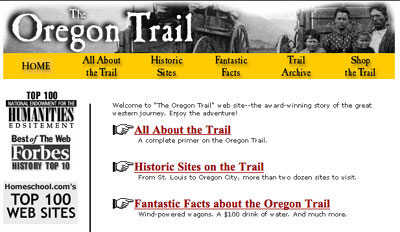talking history | syllabi | students | teachers | puzzle | about us
The Oregon Trail
http://www.isu.edu/~trinmich/Oregontrail.html.
Created and maintained by Michael Trinklein and Steve Boettcher, Idaho State University.
Reviewed April 1–13, 2001.
The Oregon Trail is the companion Web site for a documentary of the same title that aired nationally on PBS in 1995. Both are the work of Michael Trinklein, professor of mass communications, and Steve Boettcher, photographer. The site’s home page displays an attractively simple and easily navigated map of main subject headings—“All about the Trail,” "Historic Sites on the Trail,“ "Fantastic Facts about the Oregon Trail,” “Trail Archive,” and (inevitably) “Shop the Oregon Trail”—leading to descriptive and interpretive material, video clips of interviews with historians, 360% panoramic views of historic sites, full texts of diaries and journals, and several hundred links. The site is extremely popular, reportedly receiving a hundred thousand hits per month and ranking on several lists of the top history Web sites. Despite the enthusiasm, however, the historical content of The Oregon Trail is rather modest, and above all the site seems dedicated to the sale of Trinklein and Boettcher’s videos, books, and other products.
Clicking on the heading “All about the Trail” leads to a secondary set of topics that lead to short and pointed discussions, illustrated by excerpts from emigrant diaries and journals, and frequently accompanied by photographs or historic illustrations, none of which is identified. The writing is unexceptional, and, while I was happy to find no glaring errors, I was unimpressed with the interpretations, which generally privilege the exceptional over the ordinary. The section on “Native Americans,” for example, makes the correct point that contacts between emigrants and Indians were for the most part friendly but provides few details. Most of the section is devoted to cataloging conflicts between emigrants and Indians, which seems to contradict the basic point. There is little to suggest new historical perspectives on the trail experience—the history of gender roles, epidemic disease, or environmental impact. Another main heading, “Historic Sites on the Trail,” links to generally good discussions of some twenty locations from the Missouri River towns to the Pacific coast, while “Trail Archive” provides the text of nineteen diaries, journals, and nineteenth-century books on the trail experience, all fully searchable.
Video clips and panoramic views (both in QuickTime format) are interspersed throughout the site. Brief sound bites from four historians, among them the late Merrill Mattes, formerly of the National Park Service, add almost nothing of value, although Mattes’s candid comments can be entertaining. The panoramas require a broadband connection to load and run efficiently, and, aside from the bells-and-whistles factor, could be replaced with simple photographs. The links to other Web sites are a useful feature, providing access to information from state parks, municipalities, and museums.
I estimate that the site contains about twelve thousand words of original text, the equivalent of a long article. There is no bibliography. Instead, “Shop the Oregon Trail” provides a list of videos, books (some standards, but not others), and computer games, sold through Amazon.com, described as the site’s “partner” (financial?). The Oregon Trail sees itself as the place to begin exploring the history of the Oregon Trail on the Web, but other sites might work as well or better—especially Elizabeth Larson’s Links to the Oregon Trail . Neither Web site, however, comes even close to what could be learned during a visit to a branch of the public library.
John Mack Faragher
Yale University
New Haven, Connecticut

